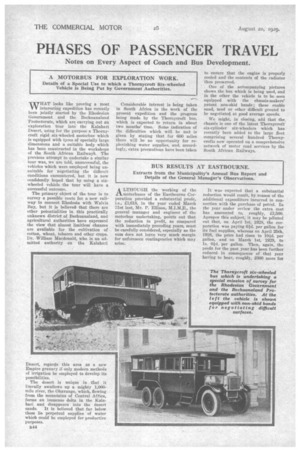BUS RESULTS AT EASTBOURNE.
Page 70

Page 71

If you've noticed an error in this article please click here to report it so we can fix it.
Extracts from the Municipality's Annual Bus Report and Details of the General Manager's Observations.
ALTHOLTGH the working of the motorbuses of the Eastbourne Corporation provided a substantial profit, i.e., £3,618, in the year ended March
81st last, Mr. P. Ellison, the general manager and engineer of the motorbus undertaking, points out that the reduction in profit, as compared with immediately preceding years, must be carefully considered, especially as the sum does not leave very much margin for unforeseen contingencies which may arise. It was expected that a substantial reduction would result, by reason of the additional expenditure incurred in connection with the purchase of petrol. In the year under review the extra cost has amounted to, roughly, 13,500. Apropos this subject, it may be painted out that, on April let, 1928, the corporation was paying 60. per gallon for its fuel supplies, whereas on April 25th, 1928, the price had risen to 100. per gallon, and on March 1st, 1929, to is. 0/d. per gallon. Then, again, the profit for the past year has been further reduced in consequence of that year having to bear, roughly, 1600 more for income tax, owing to the large profits of the previous year.
The Eastbourne municipal bus undertaking_is still in a very sound position, but Mr. Ellison stresses the need for carefully considering whether there is an excessive service on any of the routes, which affects not only the cost of petrol, oil, tyres, etc., but also the size of the staff. A point of importance is that he recognizes the desirability of instituting some systematic scheme for replacing old vehicles, as it is generally understood that there comes a time when obsolete models should be scrapped and replaced by new buses.
• In the year with which we are dealing the gross revenue amounted to £79,489, as compared with £74,205 in the previous year, the total expenditure in these years (other than loan charges and other special items) amounting to £65,711 an £56,095 respectively. Thus it will be ken that the gross profit for the past year was £13,778, as compared with £18,110 a year earlier. After deducting loan charges, the net profit comes out at £3,618, as against £9,221.
In the year ended March 31st last, 13,864,448 passengers were carried, this figure being over one million in excess of that for the previous year, -whilst • the number of miles run increased from 1.086,658 in 1927-28 to 1,215,732 in 1928-29. The number of passengers carried per bus-mile was 11.40, this figure showing a drop of .43 as contrasted with that for the previous year. As in former years, the net revenue account has been charged with the amount for depreciation during the year, this being £7,557, or approximately 20 per cent, of the value of the buses as at March 31st, 1928. After transferring the past year's profit to the profit appropriation account and charging certain other items set out in the accounts, there is at the end of the year a balance to carry for ward of £34,876. The reserve fund now stands at £14,946.
On March 31st last the Eastbourne Corporation owned 50 buses, all of them
being of Leyland make; 28 are singledeckers, the others being double-deckers. During the past year 21 vehicles were converted to run on pneumatic tyres.
In his report Mr. Ellison makes an observation which is not without significance. He points out that, in the future, it is probable that the crude-oil engine will be developed.




















































































































